NRSG 2: Exploring Safety, Legal, and Ethical Issues in Nursing
VerifiedAdded on 2023/06/03
|9
|2221
|435
Report
AI Summary
This report examines the multifaceted role of a surgical nurse, focusing on patient safety, legal responsibilities, and ethical considerations. It details the unique requirements of surgical nurses, emphasizing the need for familiarity with various body systems and illnesses. Key safety concerns, including maintaining a safe environment and preventing medical errors, are addressed in accordance with universal protocols. The report also explores the ethical provisions that govern nursing practice, particularly concerning patient privacy and confidentiality, highlighting the limitations and challenges nurses face in balancing ethical obligations with patient care. The discussion extends to patient rights, including access to healthcare, privacy, and the right to refuse treatment, while also considering the rights and involvement of carers in the treatment process. This document is available on Desklib, where students can find a wealth of resources including past papers and solved assignments.
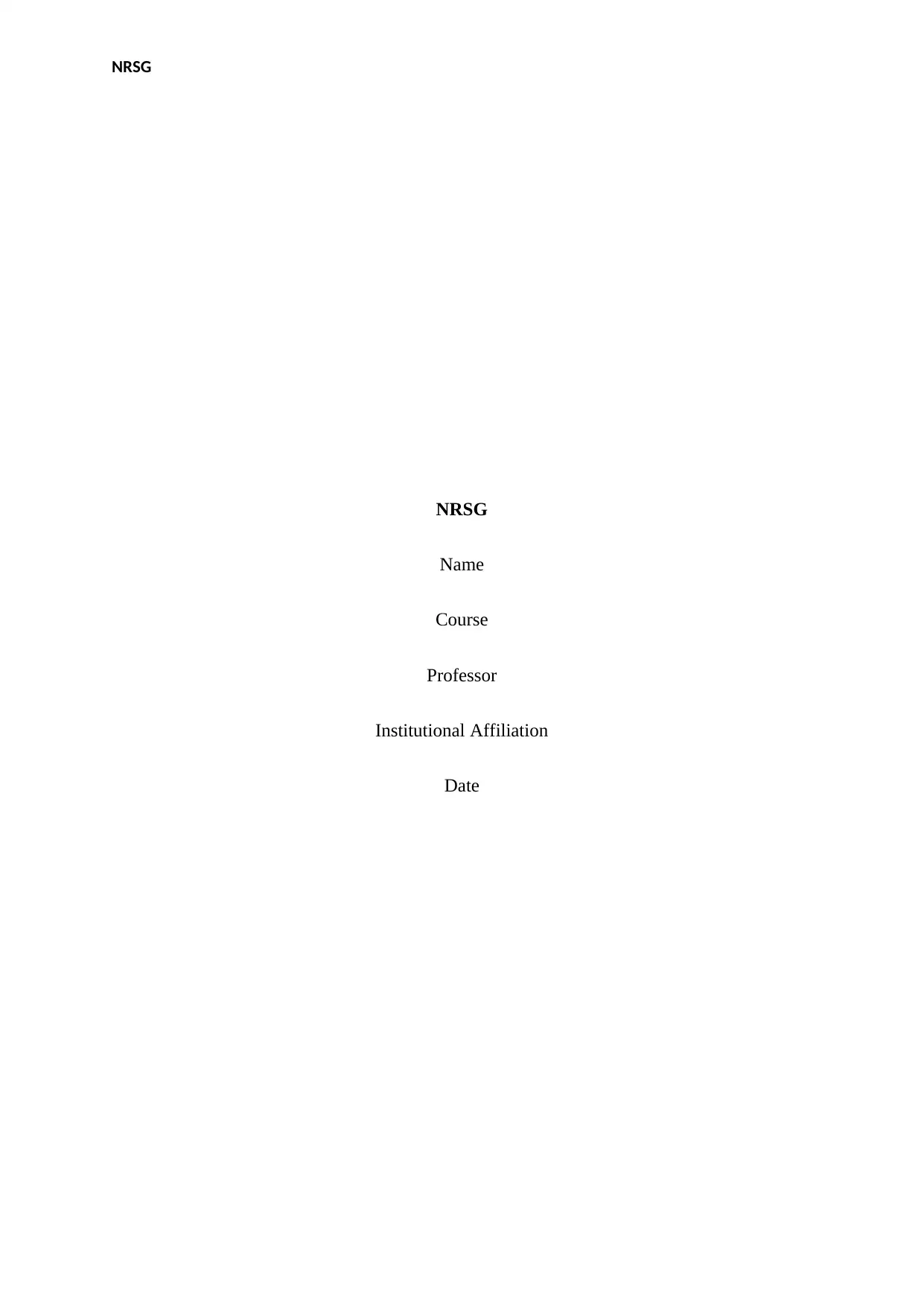
NRSG
NRSG
Name
Course
Professor
Institutional Affiliation
Date
NRSG
Name
Course
Professor
Institutional Affiliation
Date
Paraphrase This Document
Need a fresh take? Get an instant paraphrase of this document with our AI Paraphraser
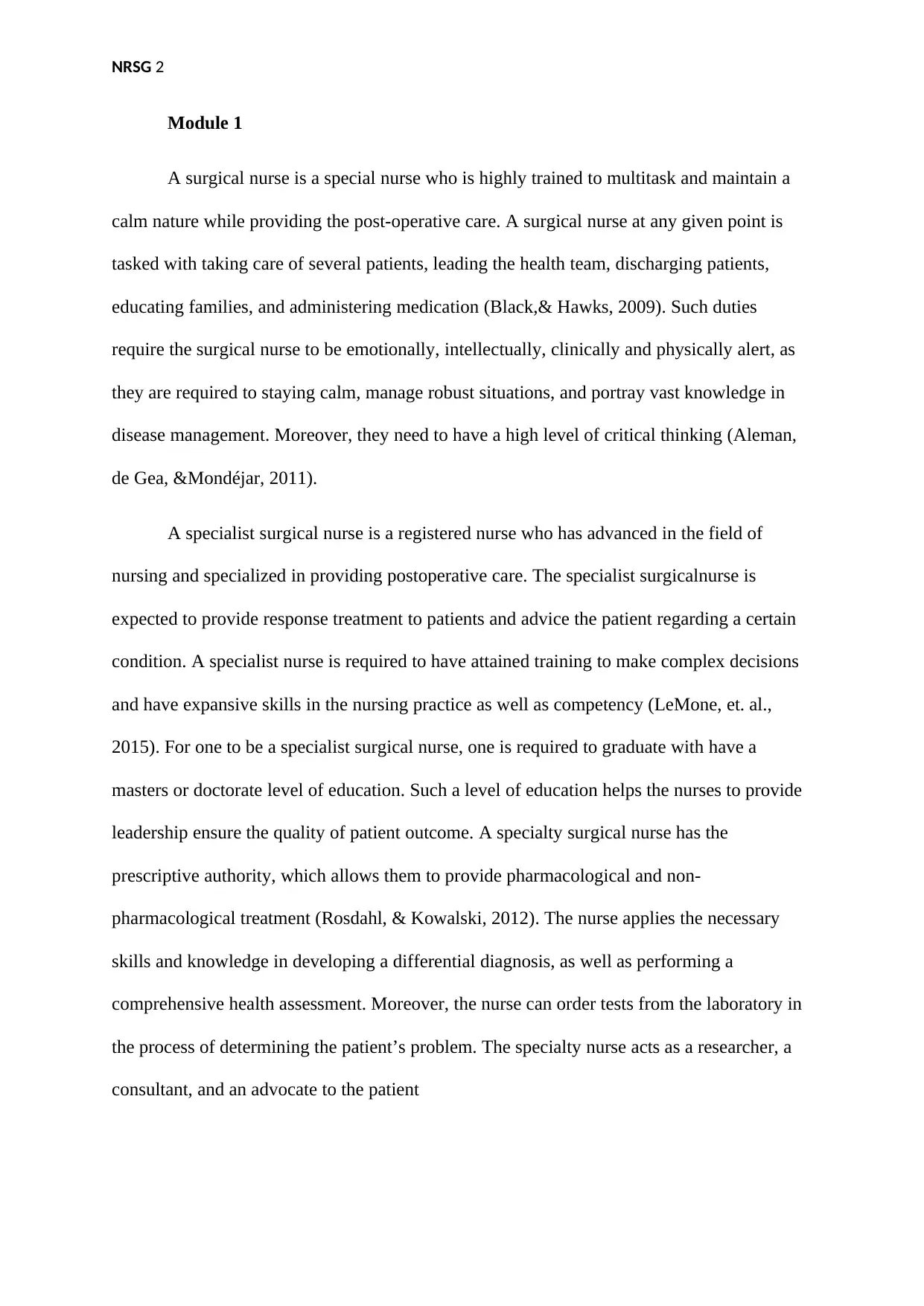
NRSG 2
Module 1
A surgical nurse is a special nurse who is highly trained to multitask and maintain a
calm nature while providing the post-operative care. A surgical nurse at any given point is
tasked with taking care of several patients, leading the health team, discharging patients,
educating families, and administering medication (Black,& Hawks, 2009). Such duties
require the surgical nurse to be emotionally, intellectually, clinically and physically alert, as
they are required to staying calm, manage robust situations, and portray vast knowledge in
disease management. Moreover, they need to have a high level of critical thinking (Aleman,
de Gea, &Mondéjar, 2011).
A specialist surgical nurse is a registered nurse who has advanced in the field of
nursing and specialized in providing postoperative care. The specialist surgicalnurse is
expected to provide response treatment to patients and advice the patient regarding a certain
condition. A specialist nurse is required to have attained training to make complex decisions
and have expansive skills in the nursing practice as well as competency (LeMone, et. al.,
2015). For one to be a specialist surgical nurse, one is required to graduate with have a
masters or doctorate level of education. Such a level of education helps the nurses to provide
leadership ensure the quality of patient outcome. A specialty surgical nurse has the
prescriptive authority, which allows them to provide pharmacological and non-
pharmacological treatment (Rosdahl, & Kowalski, 2012). The nurse applies the necessary
skills and knowledge in developing a differential diagnosis, as well as performing a
comprehensive health assessment. Moreover, the nurse can order tests from the laboratory in
the process of determining the patient’s problem. The specialty nurse acts as a researcher, a
consultant, and an advocate to the patient
Module 1
A surgical nurse is a special nurse who is highly trained to multitask and maintain a
calm nature while providing the post-operative care. A surgical nurse at any given point is
tasked with taking care of several patients, leading the health team, discharging patients,
educating families, and administering medication (Black,& Hawks, 2009). Such duties
require the surgical nurse to be emotionally, intellectually, clinically and physically alert, as
they are required to staying calm, manage robust situations, and portray vast knowledge in
disease management. Moreover, they need to have a high level of critical thinking (Aleman,
de Gea, &Mondéjar, 2011).
A specialist surgical nurse is a registered nurse who has advanced in the field of
nursing and specialized in providing postoperative care. The specialist surgicalnurse is
expected to provide response treatment to patients and advice the patient regarding a certain
condition. A specialist nurse is required to have attained training to make complex decisions
and have expansive skills in the nursing practice as well as competency (LeMone, et. al.,
2015). For one to be a specialist surgical nurse, one is required to graduate with have a
masters or doctorate level of education. Such a level of education helps the nurses to provide
leadership ensure the quality of patient outcome. A specialty surgical nurse has the
prescriptive authority, which allows them to provide pharmacological and non-
pharmacological treatment (Rosdahl, & Kowalski, 2012). The nurse applies the necessary
skills and knowledge in developing a differential diagnosis, as well as performing a
comprehensive health assessment. Moreover, the nurse can order tests from the laboratory in
the process of determining the patient’s problem. The specialty nurse acts as a researcher, a
consultant, and an advocate to the patient
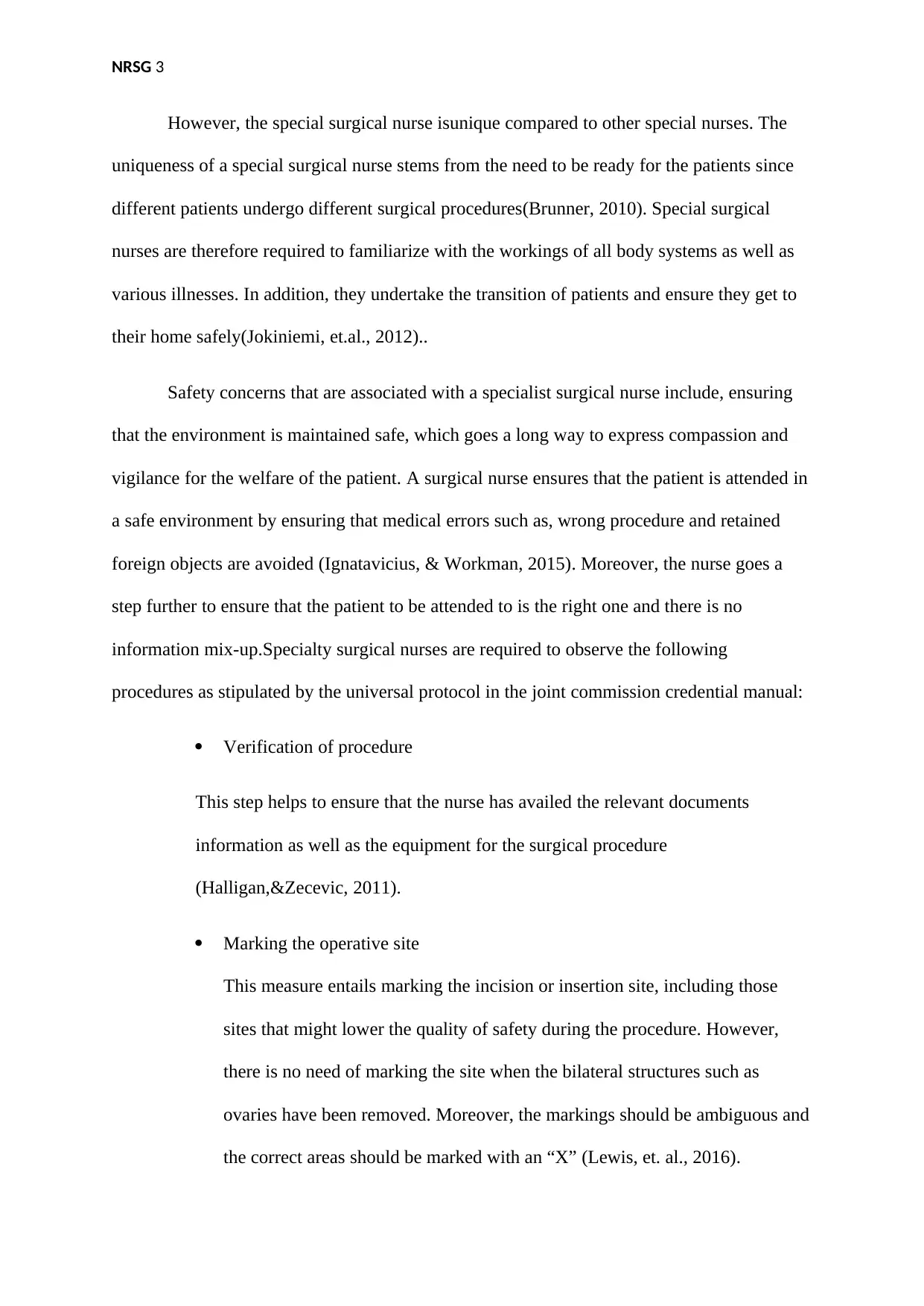
NRSG 3
However, the special surgical nurse isunique compared to other special nurses. The
uniqueness of a special surgical nurse stems from the need to be ready for the patients since
different patients undergo different surgical procedures(Brunner, 2010). Special surgical
nurses are therefore required to familiarize with the workings of all body systems as well as
various illnesses. In addition, they undertake the transition of patients and ensure they get to
their home safely(Jokiniemi, et.al., 2012)..
Safety concerns that are associated with a specialist surgical nurse include, ensuring
that the environment is maintained safe, which goes a long way to express compassion and
vigilance for the welfare of the patient. A surgical nurse ensures that the patient is attended in
a safe environment by ensuring that medical errors such as, wrong procedure and retained
foreign objects are avoided (Ignatavicius, & Workman, 2015). Moreover, the nurse goes a
step further to ensure that the patient to be attended to is the right one and there is no
information mix-up.Specialty surgical nurses are required to observe the following
procedures as stipulated by the universal protocol in the joint commission credential manual:
Verification of procedure
This step helps to ensure that the nurse has availed the relevant documents
information as well as the equipment for the surgical procedure
(Halligan,&Zecevic, 2011).
Marking the operative site
This measure entails marking the incision or insertion site, including those
sites that might lower the quality of safety during the procedure. However,
there is no need of marking the site when the bilateral structures such as
ovaries have been removed. Moreover, the markings should be ambiguous and
the correct areas should be marked with an “X” (Lewis, et. al., 2016).
However, the special surgical nurse isunique compared to other special nurses. The
uniqueness of a special surgical nurse stems from the need to be ready for the patients since
different patients undergo different surgical procedures(Brunner, 2010). Special surgical
nurses are therefore required to familiarize with the workings of all body systems as well as
various illnesses. In addition, they undertake the transition of patients and ensure they get to
their home safely(Jokiniemi, et.al., 2012)..
Safety concerns that are associated with a specialist surgical nurse include, ensuring
that the environment is maintained safe, which goes a long way to express compassion and
vigilance for the welfare of the patient. A surgical nurse ensures that the patient is attended in
a safe environment by ensuring that medical errors such as, wrong procedure and retained
foreign objects are avoided (Ignatavicius, & Workman, 2015). Moreover, the nurse goes a
step further to ensure that the patient to be attended to is the right one and there is no
information mix-up.Specialty surgical nurses are required to observe the following
procedures as stipulated by the universal protocol in the joint commission credential manual:
Verification of procedure
This step helps to ensure that the nurse has availed the relevant documents
information as well as the equipment for the surgical procedure
(Halligan,&Zecevic, 2011).
Marking the operative site
This measure entails marking the incision or insertion site, including those
sites that might lower the quality of safety during the procedure. However,
there is no need of marking the site when the bilateral structures such as
ovaries have been removed. Moreover, the markings should be ambiguous and
the correct areas should be marked with an “X” (Lewis, et. al., 2016).
⊘ This is a preview!⊘
Do you want full access?
Subscribe today to unlock all pages.

Trusted by 1+ million students worldwide
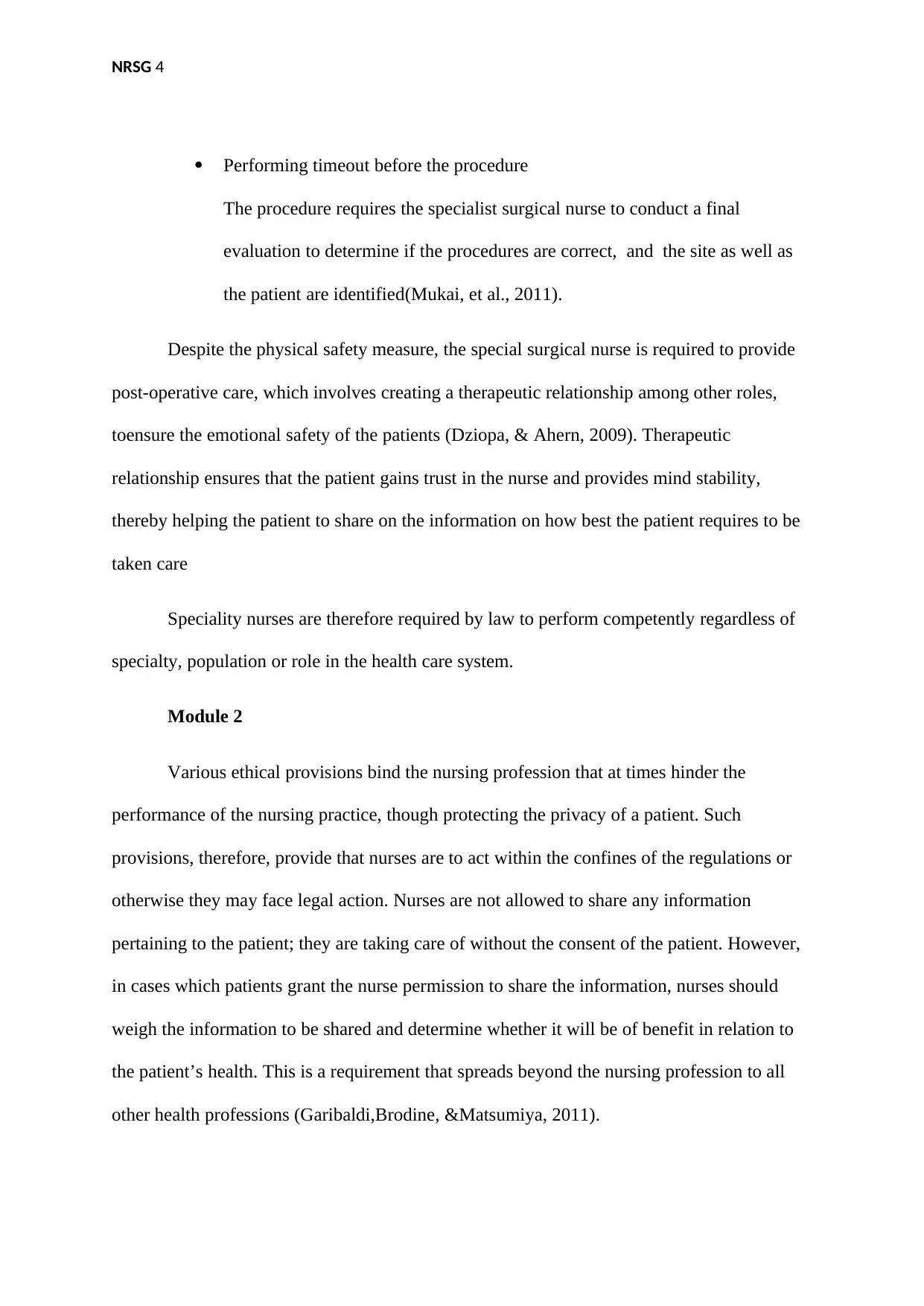
NRSG 4
Performing timeout before the procedure
The procedure requires the specialist surgical nurse to conduct a final
evaluation to determine if the procedures are correct, and the site as well as
the patient are identified(Mukai, et al., 2011).
Despite the physical safety measure, the special surgical nurse is required to provide
post-operative care, which involves creating a therapeutic relationship among other roles,
toensure the emotional safety of the patients (Dziopa, & Ahern, 2009). Therapeutic
relationship ensures that the patient gains trust in the nurse and provides mind stability,
thereby helping the patient to share on the information on how best the patient requires to be
taken care
Speciality nurses are therefore required by law to perform competently regardless of
specialty, population or role in the health care system.
Module 2
Various ethical provisions bind the nursing profession that at times hinder the
performance of the nursing practice, though protecting the privacy of a patient. Such
provisions, therefore, provide that nurses are to act within the confines of the regulations or
otherwise they may face legal action. Nurses are not allowed to share any information
pertaining to the patient; they are taking care of without the consent of the patient. However,
in cases which patients grant the nurse permission to share the information, nurses should
weigh the information to be shared and determine whether it will be of benefit in relation to
the patient’s health. This is a requirement that spreads beyond the nursing profession to all
other health professions (Garibaldi,Brodine, &Matsumiya, 2011).
Performing timeout before the procedure
The procedure requires the specialist surgical nurse to conduct a final
evaluation to determine if the procedures are correct, and the site as well as
the patient are identified(Mukai, et al., 2011).
Despite the physical safety measure, the special surgical nurse is required to provide
post-operative care, which involves creating a therapeutic relationship among other roles,
toensure the emotional safety of the patients (Dziopa, & Ahern, 2009). Therapeutic
relationship ensures that the patient gains trust in the nurse and provides mind stability,
thereby helping the patient to share on the information on how best the patient requires to be
taken care
Speciality nurses are therefore required by law to perform competently regardless of
specialty, population or role in the health care system.
Module 2
Various ethical provisions bind the nursing profession that at times hinder the
performance of the nursing practice, though protecting the privacy of a patient. Such
provisions, therefore, provide that nurses are to act within the confines of the regulations or
otherwise they may face legal action. Nurses are not allowed to share any information
pertaining to the patient; they are taking care of without the consent of the patient. However,
in cases which patients grant the nurse permission to share the information, nurses should
weigh the information to be shared and determine whether it will be of benefit in relation to
the patient’s health. This is a requirement that spreads beyond the nursing profession to all
other health professions (Garibaldi,Brodine, &Matsumiya, 2011).
Paraphrase This Document
Need a fresh take? Get an instant paraphrase of this document with our AI Paraphraser
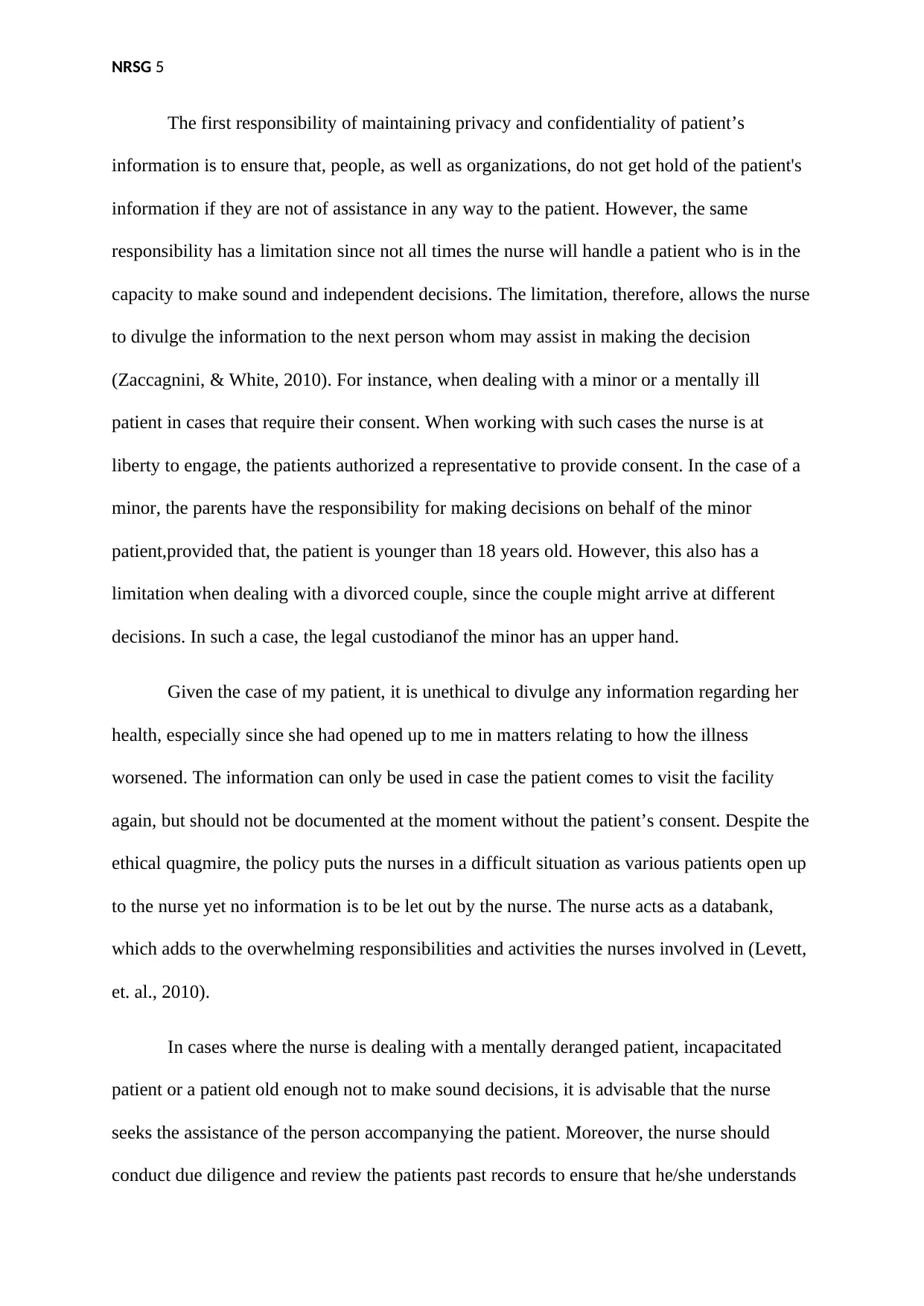
NRSG 5
The first responsibility of maintaining privacy and confidentiality of patient’s
information is to ensure that, people, as well as organizations, do not get hold of the patient's
information if they are not of assistance in any way to the patient. However, the same
responsibility has a limitation since not all times the nurse will handle a patient who is in the
capacity to make sound and independent decisions. The limitation, therefore, allows the nurse
to divulge the information to the next person whom may assist in making the decision
(Zaccagnini, & White, 2010). For instance, when dealing with a minor or a mentally ill
patient in cases that require their consent. When working with such cases the nurse is at
liberty to engage, the patients authorized a representative to provide consent. In the case of a
minor, the parents have the responsibility for making decisions on behalf of the minor
patient,provided that, the patient is younger than 18 years old. However, this also has a
limitation when dealing with a divorced couple, since the couple might arrive at different
decisions. In such a case, the legal custodianof the minor has an upper hand.
Given the case of my patient, it is unethical to divulge any information regarding her
health, especially since she had opened up to me in matters relating to how the illness
worsened. The information can only be used in case the patient comes to visit the facility
again, but should not be documented at the moment without the patient’s consent. Despite the
ethical quagmire, the policy puts the nurses in a difficult situation as various patients open up
to the nurse yet no information is to be let out by the nurse. The nurse acts as a databank,
which adds to the overwhelming responsibilities and activities the nurses involved in (Levett,
et. al., 2010).
In cases where the nurse is dealing with a mentally deranged patient, incapacitated
patient or a patient old enough not to make sound decisions, it is advisable that the nurse
seeks the assistance of the person accompanying the patient. Moreover, the nurse should
conduct due diligence and review the patients past records to ensure that he/she understands
The first responsibility of maintaining privacy and confidentiality of patient’s
information is to ensure that, people, as well as organizations, do not get hold of the patient's
information if they are not of assistance in any way to the patient. However, the same
responsibility has a limitation since not all times the nurse will handle a patient who is in the
capacity to make sound and independent decisions. The limitation, therefore, allows the nurse
to divulge the information to the next person whom may assist in making the decision
(Zaccagnini, & White, 2010). For instance, when dealing with a minor or a mentally ill
patient in cases that require their consent. When working with such cases the nurse is at
liberty to engage, the patients authorized a representative to provide consent. In the case of a
minor, the parents have the responsibility for making decisions on behalf of the minor
patient,provided that, the patient is younger than 18 years old. However, this also has a
limitation when dealing with a divorced couple, since the couple might arrive at different
decisions. In such a case, the legal custodianof the minor has an upper hand.
Given the case of my patient, it is unethical to divulge any information regarding her
health, especially since she had opened up to me in matters relating to how the illness
worsened. The information can only be used in case the patient comes to visit the facility
again, but should not be documented at the moment without the patient’s consent. Despite the
ethical quagmire, the policy puts the nurses in a difficult situation as various patients open up
to the nurse yet no information is to be let out by the nurse. The nurse acts as a databank,
which adds to the overwhelming responsibilities and activities the nurses involved in (Levett,
et. al., 2010).
In cases where the nurse is dealing with a mentally deranged patient, incapacitated
patient or a patient old enough not to make sound decisions, it is advisable that the nurse
seeks the assistance of the person accompanying the patient. Moreover, the nurse should
conduct due diligence and review the patients past records to ensure that he/she understands
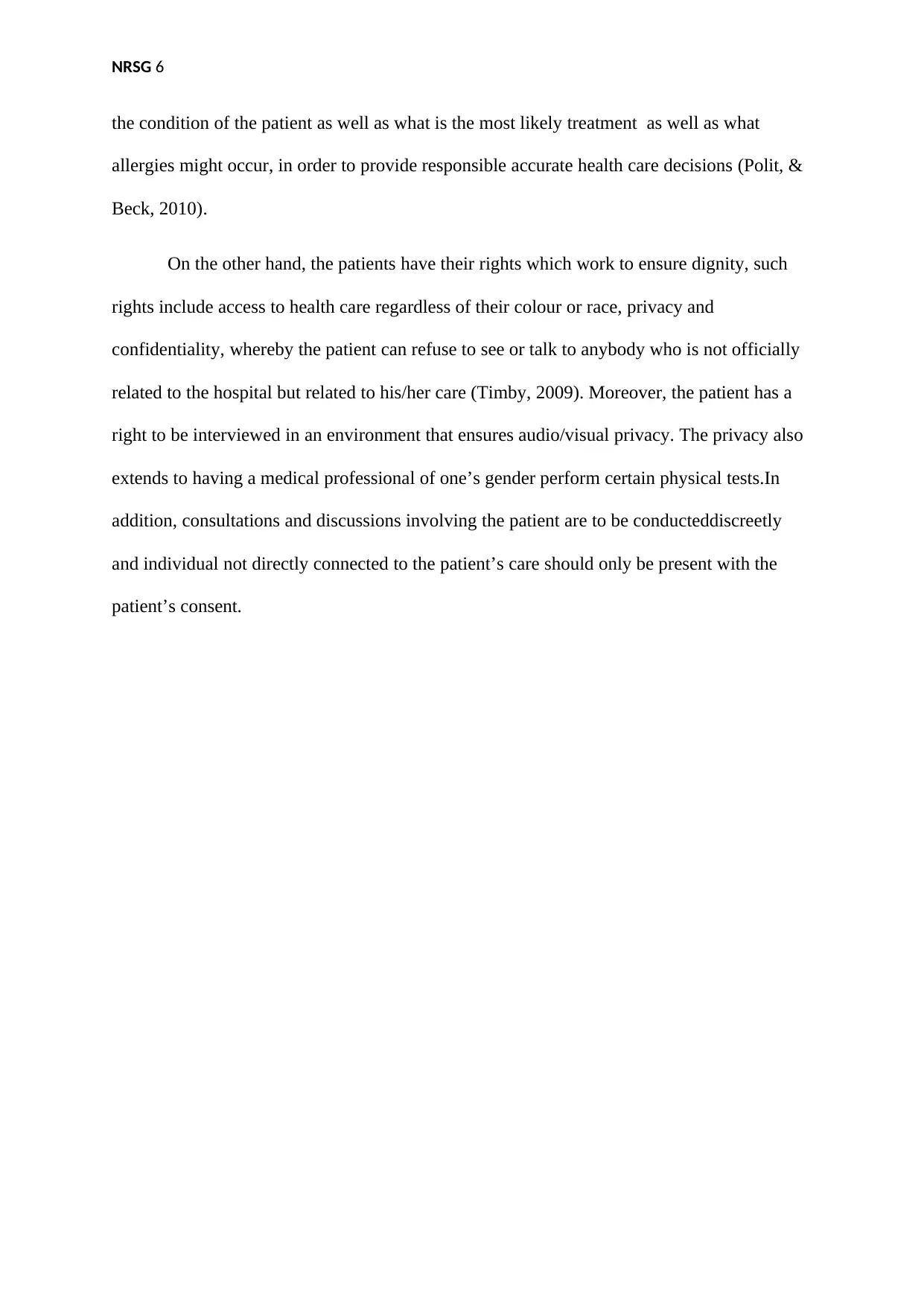
NRSG 6
the condition of the patient as well as what is the most likely treatment as well as what
allergies might occur, in order to provide responsible accurate health care decisions (Polit, &
Beck, 2010).
On the other hand, the patients have their rights which work to ensure dignity, such
rights include access to health care regardless of their colour or race, privacy and
confidentiality, whereby the patient can refuse to see or talk to anybody who is not officially
related to the hospital but related to his/her care (Timby, 2009). Moreover, the patient has a
right to be interviewed in an environment that ensures audio/visual privacy. The privacy also
extends to having a medical professional of one’s gender perform certain physical tests.In
addition, consultations and discussions involving the patient are to be conducteddiscreetly
and individual not directly connected to the patient’s care should only be present with the
patient’s consent.
the condition of the patient as well as what is the most likely treatment as well as what
allergies might occur, in order to provide responsible accurate health care decisions (Polit, &
Beck, 2010).
On the other hand, the patients have their rights which work to ensure dignity, such
rights include access to health care regardless of their colour or race, privacy and
confidentiality, whereby the patient can refuse to see or talk to anybody who is not officially
related to the hospital but related to his/her care (Timby, 2009). Moreover, the patient has a
right to be interviewed in an environment that ensures audio/visual privacy. The privacy also
extends to having a medical professional of one’s gender perform certain physical tests.In
addition, consultations and discussions involving the patient are to be conducteddiscreetly
and individual not directly connected to the patient’s care should only be present with the
patient’s consent.
⊘ This is a preview!⊘
Do you want full access?
Subscribe today to unlock all pages.

Trusted by 1+ million students worldwide
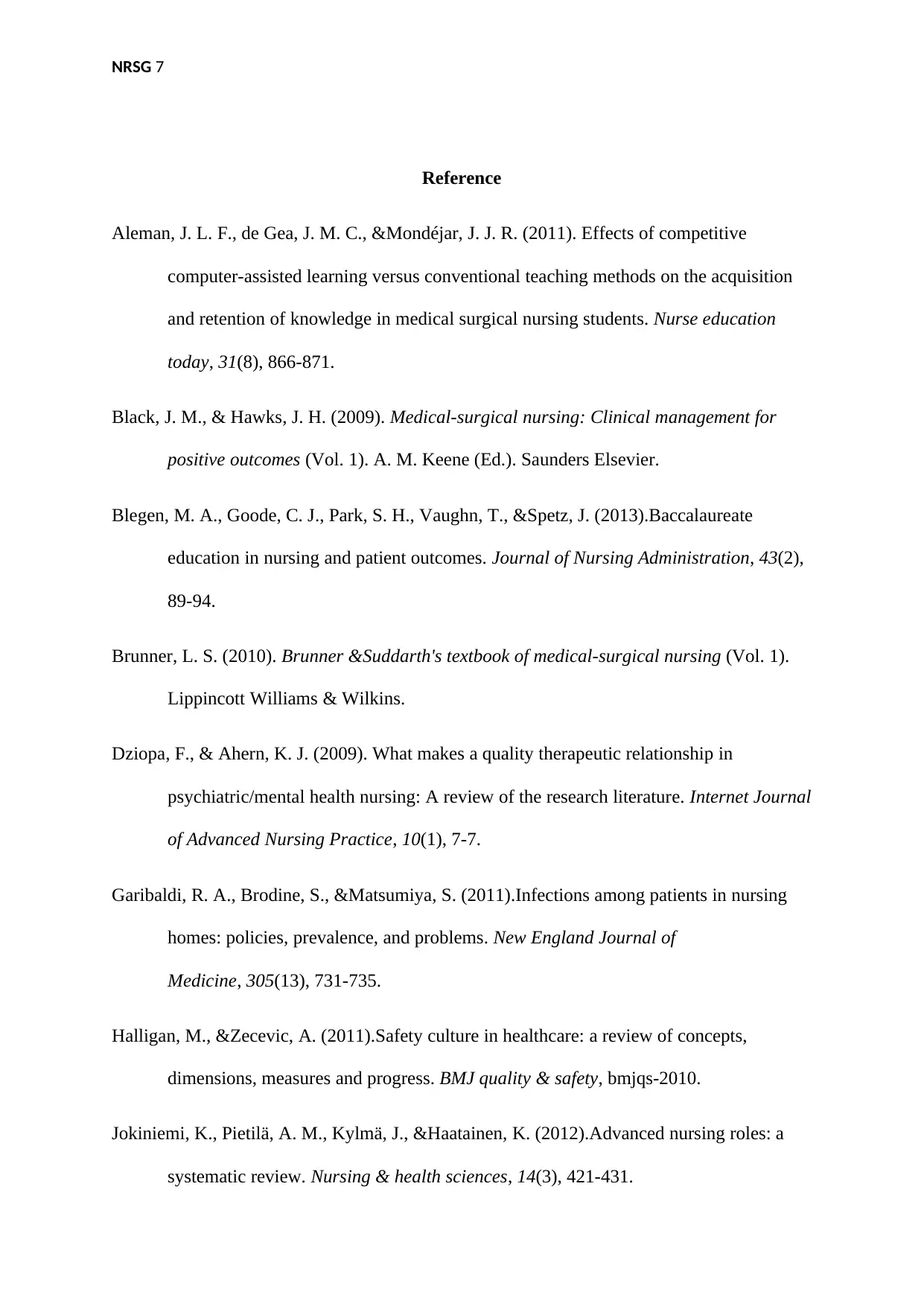
NRSG 7
Reference
Aleman, J. L. F., de Gea, J. M. C., &Mondéjar, J. J. R. (2011). Effects of competitive
computer-assisted learning versus conventional teaching methods on the acquisition
and retention of knowledge in medical surgical nursing students. Nurse education
today, 31(8), 866-871.
Black, J. M., & Hawks, J. H. (2009). Medical-surgical nursing: Clinical management for
positive outcomes (Vol. 1). A. M. Keene (Ed.). Saunders Elsevier.
Blegen, M. A., Goode, C. J., Park, S. H., Vaughn, T., &Spetz, J. (2013).Baccalaureate
education in nursing and patient outcomes. Journal of Nursing Administration, 43(2),
89-94.
Brunner, L. S. (2010). Brunner &Suddarth's textbook of medical-surgical nursing (Vol. 1).
Lippincott Williams & Wilkins.
Dziopa, F., & Ahern, K. J. (2009). What makes a quality therapeutic relationship in
psychiatric/mental health nursing: A review of the research literature. Internet Journal
of Advanced Nursing Practice, 10(1), 7-7.
Garibaldi, R. A., Brodine, S., &Matsumiya, S. (2011).Infections among patients in nursing
homes: policies, prevalence, and problems. New England Journal of
Medicine, 305(13), 731-735.
Halligan, M., &Zecevic, A. (2011).Safety culture in healthcare: a review of concepts,
dimensions, measures and progress. BMJ quality & safety, bmjqs-2010.
Jokiniemi, K., Pietilä, A. M., Kylmä, J., &Haatainen, K. (2012).Advanced nursing roles: a
systematic review. Nursing & health sciences, 14(3), 421-431.
Reference
Aleman, J. L. F., de Gea, J. M. C., &Mondéjar, J. J. R. (2011). Effects of competitive
computer-assisted learning versus conventional teaching methods on the acquisition
and retention of knowledge in medical surgical nursing students. Nurse education
today, 31(8), 866-871.
Black, J. M., & Hawks, J. H. (2009). Medical-surgical nursing: Clinical management for
positive outcomes (Vol. 1). A. M. Keene (Ed.). Saunders Elsevier.
Blegen, M. A., Goode, C. J., Park, S. H., Vaughn, T., &Spetz, J. (2013).Baccalaureate
education in nursing and patient outcomes. Journal of Nursing Administration, 43(2),
89-94.
Brunner, L. S. (2010). Brunner &Suddarth's textbook of medical-surgical nursing (Vol. 1).
Lippincott Williams & Wilkins.
Dziopa, F., & Ahern, K. J. (2009). What makes a quality therapeutic relationship in
psychiatric/mental health nursing: A review of the research literature. Internet Journal
of Advanced Nursing Practice, 10(1), 7-7.
Garibaldi, R. A., Brodine, S., &Matsumiya, S. (2011).Infections among patients in nursing
homes: policies, prevalence, and problems. New England Journal of
Medicine, 305(13), 731-735.
Halligan, M., &Zecevic, A. (2011).Safety culture in healthcare: a review of concepts,
dimensions, measures and progress. BMJ quality & safety, bmjqs-2010.
Jokiniemi, K., Pietilä, A. M., Kylmä, J., &Haatainen, K. (2012).Advanced nursing roles: a
systematic review. Nursing & health sciences, 14(3), 421-431.
Paraphrase This Document
Need a fresh take? Get an instant paraphrase of this document with our AI Paraphraser
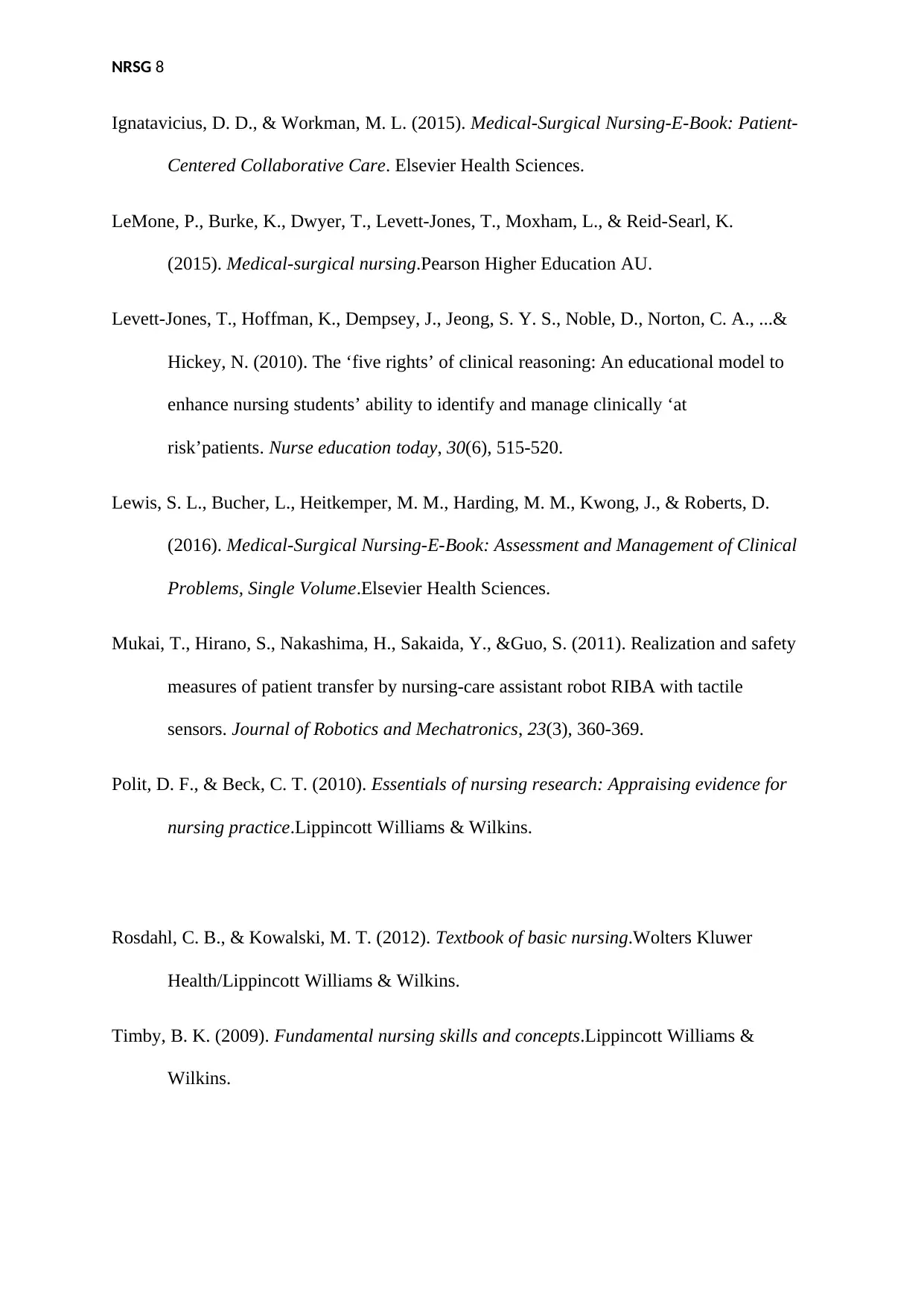
NRSG 8
Ignatavicius, D. D., & Workman, M. L. (2015). Medical-Surgical Nursing-E-Book: Patient-
Centered Collaborative Care. Elsevier Health Sciences.
LeMone, P., Burke, K., Dwyer, T., Levett-Jones, T., Moxham, L., & Reid-Searl, K.
(2015). Medical-surgical nursing.Pearson Higher Education AU.
Levett-Jones, T., Hoffman, K., Dempsey, J., Jeong, S. Y. S., Noble, D., Norton, C. A., ...&
Hickey, N. (2010). The ‘five rights’ of clinical reasoning: An educational model to
enhance nursing students’ ability to identify and manage clinically ‘at
risk’patients. Nurse education today, 30(6), 515-520.
Lewis, S. L., Bucher, L., Heitkemper, M. M., Harding, M. M., Kwong, J., & Roberts, D.
(2016). Medical-Surgical Nursing-E-Book: Assessment and Management of Clinical
Problems, Single Volume.Elsevier Health Sciences.
Mukai, T., Hirano, S., Nakashima, H., Sakaida, Y., &Guo, S. (2011). Realization and safety
measures of patient transfer by nursing-care assistant robot RIBA with tactile
sensors. Journal of Robotics and Mechatronics, 23(3), 360-369.
Polit, D. F., & Beck, C. T. (2010). Essentials of nursing research: Appraising evidence for
nursing practice.Lippincott Williams & Wilkins.
Rosdahl, C. B., & Kowalski, M. T. (2012). Textbook of basic nursing.Wolters Kluwer
Health/Lippincott Williams & Wilkins.
Timby, B. K. (2009). Fundamental nursing skills and concepts.Lippincott Williams &
Wilkins.
Ignatavicius, D. D., & Workman, M. L. (2015). Medical-Surgical Nursing-E-Book: Patient-
Centered Collaborative Care. Elsevier Health Sciences.
LeMone, P., Burke, K., Dwyer, T., Levett-Jones, T., Moxham, L., & Reid-Searl, K.
(2015). Medical-surgical nursing.Pearson Higher Education AU.
Levett-Jones, T., Hoffman, K., Dempsey, J., Jeong, S. Y. S., Noble, D., Norton, C. A., ...&
Hickey, N. (2010). The ‘five rights’ of clinical reasoning: An educational model to
enhance nursing students’ ability to identify and manage clinically ‘at
risk’patients. Nurse education today, 30(6), 515-520.
Lewis, S. L., Bucher, L., Heitkemper, M. M., Harding, M. M., Kwong, J., & Roberts, D.
(2016). Medical-Surgical Nursing-E-Book: Assessment and Management of Clinical
Problems, Single Volume.Elsevier Health Sciences.
Mukai, T., Hirano, S., Nakashima, H., Sakaida, Y., &Guo, S. (2011). Realization and safety
measures of patient transfer by nursing-care assistant robot RIBA with tactile
sensors. Journal of Robotics and Mechatronics, 23(3), 360-369.
Polit, D. F., & Beck, C. T. (2010). Essentials of nursing research: Appraising evidence for
nursing practice.Lippincott Williams & Wilkins.
Rosdahl, C. B., & Kowalski, M. T. (2012). Textbook of basic nursing.Wolters Kluwer
Health/Lippincott Williams & Wilkins.
Timby, B. K. (2009). Fundamental nursing skills and concepts.Lippincott Williams &
Wilkins.
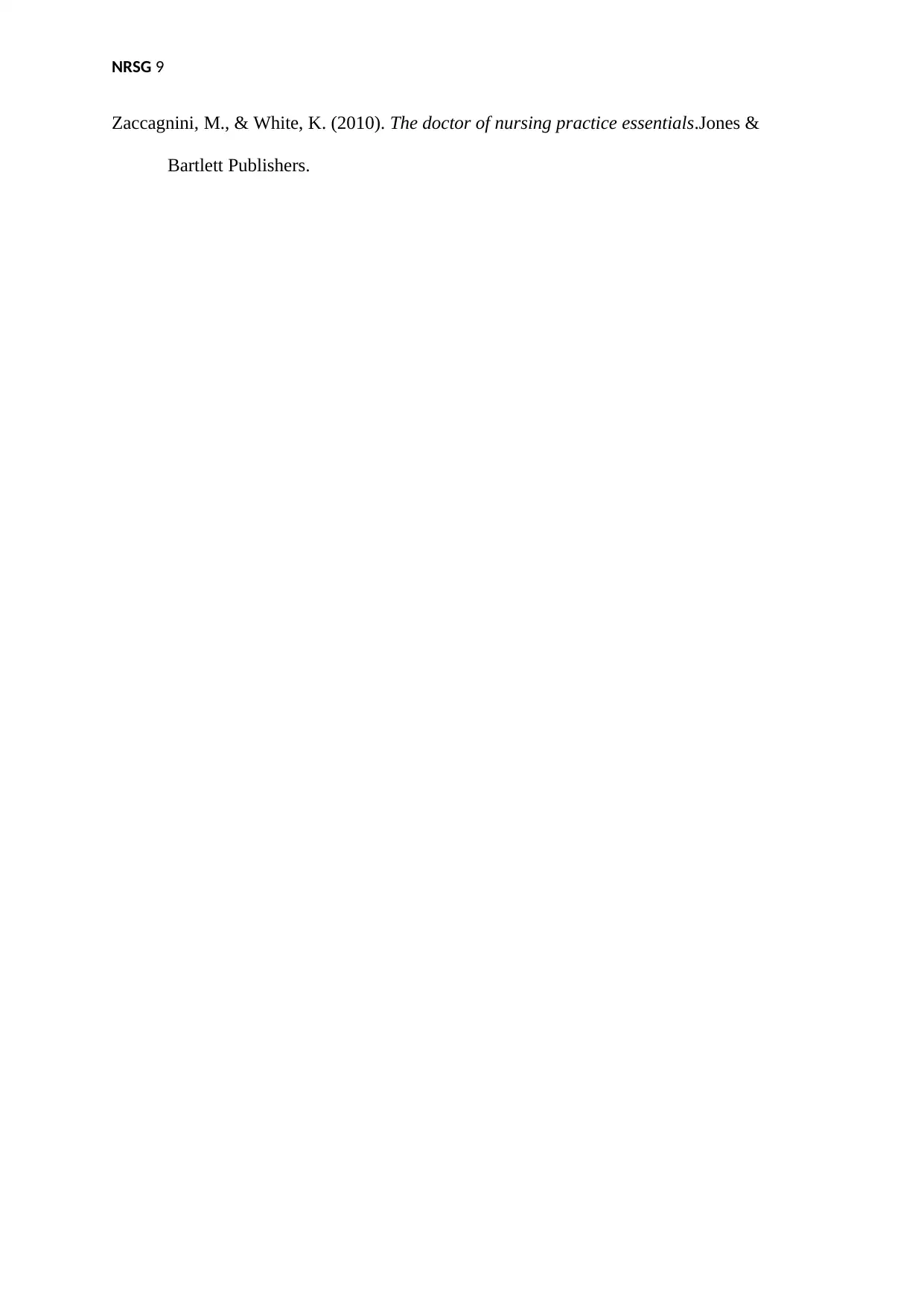
NRSG 9
Zaccagnini, M., & White, K. (2010). The doctor of nursing practice essentials.Jones &
Bartlett Publishers.
Zaccagnini, M., & White, K. (2010). The doctor of nursing practice essentials.Jones &
Bartlett Publishers.
⊘ This is a preview!⊘
Do you want full access?
Subscribe today to unlock all pages.

Trusted by 1+ million students worldwide
1 out of 9
Related Documents
Your All-in-One AI-Powered Toolkit for Academic Success.
+13062052269
info@desklib.com
Available 24*7 on WhatsApp / Email
![[object Object]](/_next/static/media/star-bottom.7253800d.svg)
Unlock your academic potential
Copyright © 2020–2025 A2Z Services. All Rights Reserved. Developed and managed by ZUCOL.





